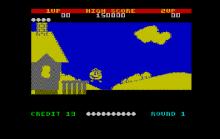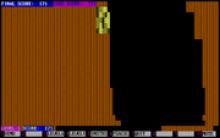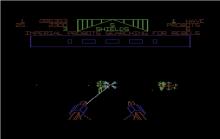Championship Manager 2
Press Keyboard right side: Alt+Enter keys to switch to full screen game play, and Alt+Enter keys to return.
How to play Championship Manager 2
Controls Overview
- Mouse: Navigate menus and click on player names or options
- Enter/Return: Confirm selections or proceed during match commentary
- Esc Key: Cancel selections or exit sub-menus
- Arrow Keys (Optional): Navigate forms and dropdowns (depending on configuration)
CM2's interface is simple but requires attention and precision.
Championship Manager 2 Description
Released in September 1995, Championship Manager 2 was a breakthrough football management simulation. Developed by Sports Interactive and published by Domark, it defined the genre for years. It improved on the 1992 original with SVGA graphics and expanded match commentary. For many players, CM2 was their first experience with true football strategy off the pitch. Its impact is still visible in modern sports simulations today.
Sports Interactive and the Rise of CM2
Sports Interactive crafted CM2 with a focus on detail, realism, and player control. Domark published the game until Eidos later took over the series. CM2 introduced the Scottish league, marking the first time players could manage outside England.

Later regional versions added Spanish, Dutch, German, and French leagues. The series would eventually split, with Sports Interactive creating Football Manager while Eidos retained the CM name.
CM2’s Interface and Gameplay Experience
Championship Manager 2 remained largely text-based, but SVGA menus and match commentary made it immersive. There was no visual match engine—just scrolling text like a live broadcast. Players controlled team lineups, formations, and individual player roles. The game offered realistic injuries, suspensions, and morale changes that shaped decisions. Despite the simple visuals, the level of control and depth created a true manager simulation.
Managing Your Squad and Making Transfers
Transfers were a core part of CM2’s appeal. Players could scout talent, place bids, and negotiate contracts. The Bosman ruling was introduced in later patches, adding realism to free transfers. Contract renewals, player morale, and aging stars forced long-term planning. Whether building for promotion or European competition, squad management was essential. Balance across positions and substitutes often made the difference in tough seasons.
Tactics, Training, and Match Day Control
CM2 offered basic but strategic tactics compared to modern games. Managers chose formations like 4-4-2, set passing styles, and adjusted defensive lines. Training schedules could be customized to develop players' physical and mental stats. On match day, text commentary revealed team performance in real time. Substitutions and tactic changes had immediate effects, making each match an interactive challenge.
League Ambitions and Financial Strategy
Each season included domestic leagues, cup competitions, and potential European qualifiers. Finishing well could boost your club’s finances through prize money and sponsorship.

CM2 also tracked attendance, wages, and transfer budgets, requiring responsible management. While stadium upgrades were limited, financial oversight was still crucial. Poor form could mean sacking, especially if board expectations weren’t met.
A Vast Football Database for Its Time
One of CM2’s greatest strengths was its detailed player database. Thousands of real players, with accurate positions, stats, and hidden attributes, made every save feel authentic. The game even included regen systems where retiring players were replaced by new prospects. This added longevity and discovery to every long-term campaign. Fans would spend hours identifying hidden gems and youth talents.
From CM2 to Football Manager: The True Successor
The Football Manager series directly evolved from the CM2 foundation. Sports Interactive continued to refine features like scouting, tactical depth, and player behavior. Modern FM games added 3D match engines and dynamic interactions. However, the heart of managing a squad through text and numbers remains intact. If you loved CM2, Football Manager carries on that tradition at a deeper level.
Compatibility and Playing CM2 Today
CM2 was designed for MS-DOS and Windows 95 systems. Running it today requires emulation or a virtual machine. DOSBox or similar tools allow the game to run on Windows 10 and Windows 11. CD-ROM versions with commentary are preferred by many retro gamers. A proper configuration ensures smooth play and nostalgia intact.
Final Thoughts on Championship Manager 2
CM2 isn't just an old football game—it’s the root of a genre. It perfected text-based simulation with realism and replayability. For fans of pure football management, CM2 remains one of the most respected entries. Its systems were deep enough to feel rewarding without overwhelming new players. Even now, retro fans find joy building dynasties and hunting unknown stars.
Classic Reload brings to you this classic game called Championship Manager 2. CM2 is a football management sim that was released in September 1995 for PC. Those footie fanatic can't avoid to get hooked by this game as it is managing an own, personal team with every famous and semi-famous players from around the globe. Have fun!
Cheats/Hints/Walkthroughs for Championship Manager 2
Tips and Strategies for CM2 Managers
Start with a Balanced Team
For new players, choose a club like Liverpool or Newcastle with strong players and stable finances. These clubs offer more margin for error. Lower-league clubs require better scouting and patience with limited funds.
Understand Player Attributes
Each player has detailed stats like tackling, pace, creativity, and stamina. Match these to their positions. Don’t ignore lesser-known stats like consistency or flair—these affect performance long-term.
Develop a Tactical Identity
Begin with a 4-4-2 formation and learn how your team reacts. Adjust instructions based on match feedback. Keep a steady core lineup, but be flexible when facing different opponents.
Make Smart Transfers
Use free agents and loan players to fill short-term gaps. Younger players develop quickly and cost less in wages. Sell high-wage veterans if they underperform.
Use Training to Shape Your Squad
Assign custom training to improve players’ weaknesses. Rotate your squad to avoid fatigue or injury. Rest players with low stamina before crucial matches.
Don’t Ignore Morale and Injuries
Low morale leads to bad results. Praise strong performances and avoid overusing tired players. Have backups ready for suspensions and injury crises.
Save Often and Monitor Results
CM2 can be unpredictable. Save before major matches or transfer windows. Review performance monthly to adjust goals and tactics.

Championship Manager 2 - additional information















